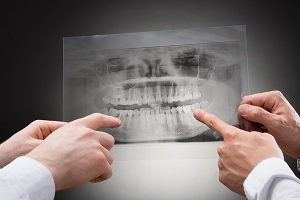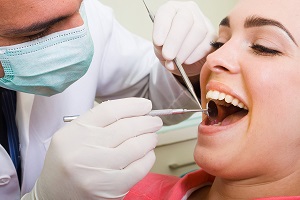
by Dr. Jacqueline S. Allen | Jun 1, 2016 | Blog, Endodontics, Endodontist, Patients
 Because so many patients equate the practice of dentistry with pain, they may often wait to seek dental care. However, patients who neglect to attend their regular dentist appointments can be more susceptible to a possible progression of infection and/or dental disease, which can lead to more serious damage in the future. Therefore, it is important for clinicians to have pre-established plans to easily handle a dental emergency. Step-by-step methodology is an easy way to alleviate some of the stress of dental emergencies.
Because so many patients equate the practice of dentistry with pain, they may often wait to seek dental care. However, patients who neglect to attend their regular dentist appointments can be more susceptible to a possible progression of infection and/or dental disease, which can lead to more serious damage in the future. Therefore, it is important for clinicians to have pre-established plans to easily handle a dental emergency. Step-by-step methodology is an easy way to alleviate some of the stress of dental emergencies.
The first step in this process is to establish a differential diagnosis of tooth pain vs. non-tooth pain. The patient’s chief complaint during a dental emergency must be taken into account when performing diagnostic tests of the tooth that is suspected to be the cause of pain, especially since it may not be tooth-related. Any anesthesia that is applied to the suspected tooth should reduce or eliminate pain. If the pain is not alleviated, the tooth may not be the source of the issue. Also, if the clinician suspects any nerve involvement in the pain, an etiology can easily be deduced, especially if the patient has had recent dental treatment, restorations that are failing, tooth decay, and/or recent trauma; any of these events can lead to inflammatory pain. A clear diagnosis must be established before moving onto the next stage of treatment.
Dental treatment reduces the inflammatory process, which is the underlying cause of most acute dental pain emergencies. Treatment of the tooth can relieve pain by reducing tissue levels of inflammatory mediators, which can lead to symptoms such as apparently random throbbing and chewing pain.
The prescription of a specific drug, such as an antibiotic or an analgesic to reduce inflammation, is the final step in managing a dental emergency. It is important to note that antibiotics should only be prescribed to patients that have signs of odontogenic infections, including swelling, fever, malaise, or compromised airways.
Toothaches are one of the most common forms of pain that overwhelm emergency rooms and dental offices. With the appropriate methodologies for treating the anxious patient, a skilled clinician can easily accommodate an acute emergency dental patient and can provide an appropriate referral for non-tooth related pain conditions.

by Dr. Jacqueline S. Allen | May 27, 2016 | Blog, Business, Dentistry, Endodontics, Endodontist, Mission of Mercy
 Team members of Phoenix Endodontic Group participated in the 2016 HopeFest event which took place April 15th-16th at CHASE Field in Phoenix. This annual event provides a wide range of sevices to the homeless and economically challenged members of our community. The Central Arizona Dental Society Foundation was asked to help deliver the dental services at HopeFest over a two day period.
Team members of Phoenix Endodontic Group participated in the 2016 HopeFest event which took place April 15th-16th at CHASE Field in Phoenix. This annual event provides a wide range of sevices to the homeless and economically challenged members of our community. The Central Arizona Dental Society Foundation was asked to help deliver the dental services at HopeFest over a two day period.
“This was such a great and it took many wonderful volunteers to make it a success,” said Dr. Jacqueline S. Allen, CADSF Board President. “We were thankful to have dental teams come together to help get folks smiling again.” Allen continued, “Several team members from offices across the Valley volunteered over the two day period.” The following team members from Phoenix Endodontic Group participated: Dr. Jacqueline Allen (Clinic Floor Director), Dallas Hedges (Endodontic Lead), Roxann Naithani (Patient Registration Lead) Hanh Duong (Patient Exit), Savannah Allen (X-Ray) and Kevin Conroy (Event Director).
 Dr. Allen also wished to thank members of the Phoenix Endodontic Group’s extended “family” for their amazing efforts: Kristen Kingsley (Event Coordinator), Sarah Tate (Event Coordinator), Linda Shirey (Volunteer Lounge) and Dr. Carol Ford (Dental Routing).
Dr. Allen also wished to thank members of the Phoenix Endodontic Group’s extended “family” for their amazing efforts: Kristen Kingsley (Event Coordinator), Sarah Tate (Event Coordinator), Linda Shirey (Volunteer Lounge) and Dr. Carol Ford (Dental Routing).
Highlights from the 2-day dental clinic include: $397,000 in free dental care delivered to 369 patients. CADSF was also able to provide dentures, root canals and crowns – these services were all provided for the first time ever at HopeFest.
Thanks to the Central Arizona Dental Society Foundation and all of the volunteers for making 2016 HopeFest a big success.


by Dr. Jacqueline S. Allen | May 18, 2016 | Blog, Dentistry, Endodontics, Endodontist
 While public awareness campaigns in recent years have highlighted the role of endodontists in dental care, the first time many patients see the way that general dentists work with endodontists is when their family dentist makes a referral to one because they need a root canal treatment or a related procedure.
While public awareness campaigns in recent years have highlighted the role of endodontists in dental care, the first time many patients see the way that general dentists work with endodontists is when their family dentist makes a referral to one because they need a root canal treatment or a related procedure.
There are several key ways in which general dentists and endodontists work together, and understanding the professional relationship that exists between the two groups of practitioners can help dental consumers better appreciate how their treatment is being delivered.
Ways In Which Dentists And Endodontists Work Together
- Making referrals. General dentists refer the most difficult cases of infected or compromised teeth to endodontists, who are specialists in the speedy resolution of such cases and experts in pain management.
- Consultations. When a general practitioner is delivering treatment, but needs additional insight on how to approach a root canal, he or she will turn to an endodontist, who can advise him or her on the best way to treat the patient.
- Serving as partners in the healing process. Because a patient may only see an endodontist at most a few times, communication between the specialist’s office and a patient’s general provider is crucial. At Phoenix Endodontic Group, referring dentists have full online access to a patient’s records, so he or she will have a convenient way to view treatment results from the endodontist’s office when the patient returns for further oral health evaluations.
“Endodontists rely on general dentists for referrals, crucial steps in the root canal treatment process, and so much more,” says Dr. Allen, who practices with the Phoenix Endodontics Group. We make every effort to make the treatment experience efficient for the practitioner and seamless for the patient.”

by Dr. Jacqueline S. Allen | Apr 27, 2016 | Blog, Endodontics, Root Canal
 When faced with the decision of saving a natural tooth through endodontic treatment, a patient should feel confident that this is the best choice for their health and cosmetic results. There are many advantages to saving the natural tooth such as: normal biting forces, efficient chewing, maintaining a natural appearance and limiting the need for more costly dental work. That coupled with the fact that dentistry has yet to produce a replacement for the natural tooth that looks, feels and FUNCTIONS as well as a natural tooth.
When faced with the decision of saving a natural tooth through endodontic treatment, a patient should feel confident that this is the best choice for their health and cosmetic results. There are many advantages to saving the natural tooth such as: normal biting forces, efficient chewing, maintaining a natural appearance and limiting the need for more costly dental work. That coupled with the fact that dentistry has yet to produce a replacement for the natural tooth that looks, feels and FUNCTIONS as well as a natural tooth.
A patient should never choose to have an extraction just because they think it will be cheaper. When a natural tooth is extracted, it will typically need to be replaced with an implant or some other dental prosthesis in order to prevent future problems. The cost of the implant or prosthesis and the extraction, is quite often, more expensive than the endodontic procedure that could help save the tooth for years to come. Most dental plans also cover endodontic procedures.
A patient should never choose extraction because they think the root canal treatment will be painful. Better anesthesia and modern techniques make most root canal treatments almost painless. In a recent study, patients that have root canal treatment are six times more likely to describe it as “painless” than patients that have never had root canal treatment at all!
A patient should never choose extraction because they think it will be quicker. Endodontic treatments generally require one or two visits lasting usually less than an hour each. Of course, an extraction is only one visit, but there can be several additional visits necessary to replace the tooth and they are usually longer.

by Dr. Jacqueline S. Allen | Apr 21, 2016 | Blog, Root Canal
 While modern root canals are safe, effective procedures that usually eliminate tooth discomfort, if you’ve never had one, you may not know what to expect immediately after your procedure.
While modern root canals are safe, effective procedures that usually eliminate tooth discomfort, if you’ve never had one, you may not know what to expect immediately after your procedure.
Here is a list of things to look for and be aware of in the days, weeks and months after your root canal treatment.
The first few days
- Don’t eat anything until the local anesthetic wears off, to avoid biting your cheek or tongue.
- Take over-the-counter or prescription pain relief medication as directed by your endodontist to deal with any discomfort after the procedure.
- To reduce post-operative swelling, you may apply ice on the cheek on the side of the face that is impacted. Try applying the ice for 10 minutes on, then 20 minutes off.
- Eat a soft diet for the first two days after the root canal. Avoid chewing directly with the tooth that received the root canal until a crown or other permanent restoration is in place.
- Brush and floss the affected tooth as you normally would.
The next few weeks
- Any discomfort you feel from the procedure itself should abate within 3 or 4 days. If it doesn’t, contact your endodontist immediately.
- If the temporary filling placed in your root canal comes out, have it replaced immediately. It’s normal to have a thin layer of filling wear off, but if all of it has come out, re-infection is a real danger.
- Make an appointment within two weeks of the root canal to receive a permanent restoration. A permanent filling or crown must be placed to ensure that bacteria don’t leak into the canal.
6 months and beyond
- It’s important to visit your endodontist occasionally after your root canal. He or she can monitor the impacted tooth and ensure the healing is continuing to progress properly.
- Although 95 percent of root canals are a success, it’s possible for a tooth to need retreatment later. The treated tooth can be damaged by injury, or become infected, or suffer extensive tooth decay, and need a root canal retreatment years or even decades later.
“Root canals are an easily tolerated procedure that is the treatment of choice to save an injured or infected tooth,” says Dr. Jacqueline S. Allen of the Phoenix Endodontic Group. “Understanding what to watch for during the post-op period will increase its likelihood of success.”

by Dr. Jacqueline S. Allen | Apr 18, 2016 | Blog, Business, Endodontics, Endodontist, Phoenix Endodontic Group
 The entire team at Phoenix Endodontic Group has a keen awareness that we are here to provide gentle and individualized care to all patients entrusted to us by our referring doctors or that have sought us out on their own. There are many endodontic specialists in the Valley, and we realize that we must always “be at our best” relative to patient care.
The entire team at Phoenix Endodontic Group has a keen awareness that we are here to provide gentle and individualized care to all patients entrusted to us by our referring doctors or that have sought us out on their own. There are many endodontic specialists in the Valley, and we realize that we must always “be at our best” relative to patient care.
Understanding what patients are seeking when they come to our office helps us be able to define what sets us apart from other endodontic specialists.
- Patients want to be treated with the state of the art equipment – Phoenix Endodontic Group consistently makes investments in technology and training to be able to deliver the best in modern endodontic therapy to our patients.
- Patients want their endodontist to listen to their concerns and fully answer their questions relative to treatment options – Phoenix Endodontic Group is the only endodontic practice in the Phoenix/Paradise Valley area with all-female practitioners. Dr. Jacqueline Allen and I have many years of experience and training treating patients with endodontic pain. We take our time with consultations and develop a treatment plan with the patients best interests in mind.
- Patients need access to care when they are experiencing pain and discomfort. No one can predict when the need for a root canal will arise. Phoenix Endodontic Group has two conveniently located offices that are open Monday – Friday from 7:00am – 5:00pm on most days.
At Phoenix Endodontic Group we live by a simple rule – Treat our patients the way we wish to be treated when we receive care. Living by this rule has help to make us one of the top endodontic specialty offices in the Phoenix/Paradise Valley area.

 Because so many patients equate the practice of dentistry with pain, they may often wait to seek dental care. However, patients who neglect to attend their regular dentist appointments can be more susceptible to a possible progression of infection and/or dental disease, which can lead to more serious damage in the future. Therefore, it is important for clinicians to have pre-established plans to easily handle a dental emergency. Step-by-step methodology is an easy way to alleviate some of the stress of dental emergencies.
Because so many patients equate the practice of dentistry with pain, they may often wait to seek dental care. However, patients who neglect to attend their regular dentist appointments can be more susceptible to a possible progression of infection and/or dental disease, which can lead to more serious damage in the future. Therefore, it is important for clinicians to have pre-established plans to easily handle a dental emergency. Step-by-step methodology is an easy way to alleviate some of the stress of dental emergencies.

 Team members of Phoenix Endodontic Group participated in the 2016 HopeFest event which took place April 15th-16th at CHASE Field in Phoenix. This annual event provides a wide range of sevices to the homeless and economically challenged members of our community. The
Team members of Phoenix Endodontic Group participated in the 2016 HopeFest event which took place April 15th-16th at CHASE Field in Phoenix. This annual event provides a wide range of sevices to the homeless and economically challenged members of our community. The  Dr. Allen also wished to thank members of the Phoenix Endodontic Group’s extended “family” for their amazing efforts: Kristen Kingsley (Event Coordinator), Sarah Tate (Event Coordinator), Linda Shirey (Volunteer Lounge) and Dr. Carol Ford (Dental Routing).
Dr. Allen also wished to thank members of the Phoenix Endodontic Group’s extended “family” for their amazing efforts: Kristen Kingsley (Event Coordinator), Sarah Tate (Event Coordinator), Linda Shirey (Volunteer Lounge) and Dr. Carol Ford (Dental Routing).

 While
While 
 When faced with the decision of saving a natural tooth through endodontic treatment, a patient should feel confident that this is the best choice for their health and cosmetic results. There are many advantages to saving the natural tooth such as: normal biting forces, efficient chewing, maintaining a natural appearance and limiting the need for more costly dental work. That coupled with the fact that dentistry has yet to produce a replacement for the natural tooth that looks, feels and FUNCTIONS as well as a natural tooth.
When faced with the decision of saving a natural tooth through endodontic treatment, a patient should feel confident that this is the best choice for their health and cosmetic results. There are many advantages to saving the natural tooth such as: normal biting forces, efficient chewing, maintaining a natural appearance and limiting the need for more costly dental work. That coupled with the fact that dentistry has yet to produce a replacement for the natural tooth that looks, feels and FUNCTIONS as well as a natural tooth.
 While modern root canals are safe, effective procedures that usually eliminate tooth discomfort, if you’ve never had one, you may not know what to expect immediately after your procedure.
While modern root canals are safe, effective procedures that usually eliminate tooth discomfort, if you’ve never had one, you may not know what to expect immediately after your procedure.